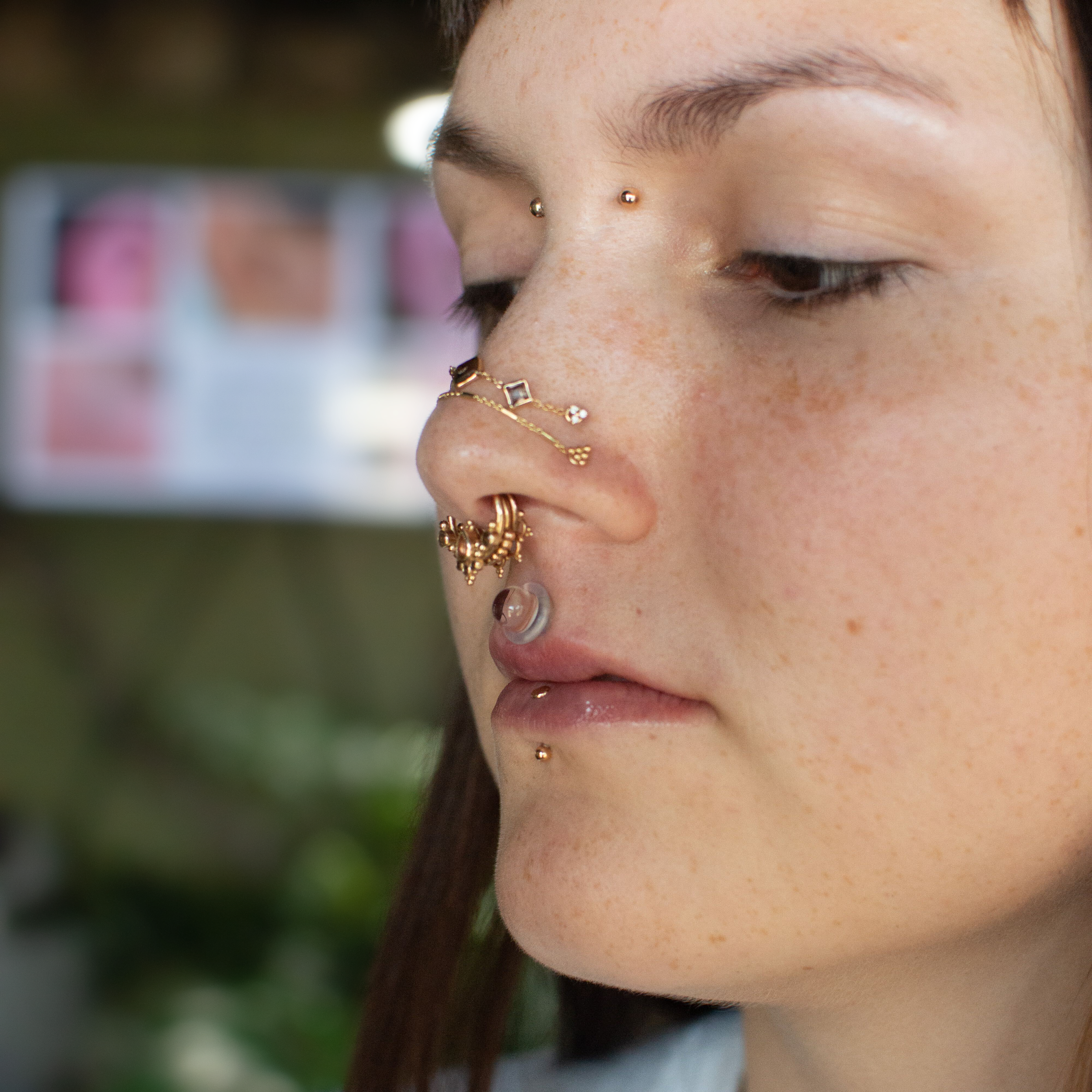Jewelry
Evolution offers New Mexico’s largest selection of quality body jewelry, including various styles of implant-grade steel, titanium, niobium, gold, and gemstones for initial piercings. We do careful research into the jewelry we offer in our studio, ensuring the manufacturers we work with are following the highest standards of safety and ethical practices.
Materials
As members of the Association of Professional Piercers (The APP), we are committed to use only materials that have been proven appropriate for wear in initial body piercings. Some metal alloys (mixtures) are endorsed based on their medical applications, such as use in medical implants, while other materials like gold and obsidian (natural glass) have been utilized in piercings for centuries, even millennia. We use only materials that can withstand the heat and pressure of autoclave sterilization, and those that are inert and biocompatible.
While there are many materials used in commercial body jewelry, only a select few are reliably suitable for fresh body piercings. Marketing terms such as “hypoallergenic” and “surgical steel” can be used to persuade buyers that a product is safe, but there are no regulatory guidelines stating that an item must meet a certain standard to label them as such. Additionally, jewelry marked as gold plated, gold filled, or gold vermeil jewelry can sometimes appear to be the same quality as that of solid 14k or 18k gold, but they involve coating a base metal with a thin layer of gold that can chip and wear off, causing harm to a healing piercing. Your entire piercing experience - including the healing - is a priority for us, so we set you up for success by using the safest materials available.
This means we don’t take words like “surgical steel” or “titanium” at face value. To use jewelry in an initial piercing, we require mill test certificates showing the steel or titanium jewelry we use in initial piercings has met biocompatibility requirements set by the American (now International) Society for Testing and Materials Standard (ASTM) and/ or the International Organization for Standardization (ISO), or by biocompatibility testing done by independent laboratories and verified by the Association of Professional piercers. We keep these documents on file to be viewed upon request.
Materials we use in initial piercings:
-
Specifically, steel that is ASTM F-138 compliant or ISO 5832-1 compliant; ISO 10993-(6,10, or 11) compliant; or (EEC [European] Nickel Directive compliant.
Steel jewelry has a cool, silver color that is polished to a mirror finish. It is a dense material and the heft compared to titanium becomes distinctly apparent in larger sizes. One of the fascinating properties of implant-grade steel is that while it contains nickel (a known allergen), a passive chromium oxide layer acts as a protective shield, minimizing the risk of nickel ions leaching out and interacting with the body, thereby offering a level of protection to those with nickel sensitivities. For this reason, reactions are rare and it can be safely worn by all but the most sensitive individuals.
-
(Ti6Al4V ELI) that is ASTM F-136 compliant, ASTM F1295, ISO 5832-3 compliant, or commercially pure titanium that is ASTM F-67 compliant.
Titanium jewelry is grayish silver in its natural form, and it can also be polished to a mirror finish. Titanium is renowned for its biocompatibility, making it a top choice for those with metal sensitivities. A fun quality of titanium is its ability to be anodized - this is an electrochemical process that thickens the oxide layer on the metal's surface, allowing it to refract light and display various colors without the use of dyes or pigments. This means that titanium can be made into a rainbow of colors for body jewelry. Colors can fade depending on biochemistry and friction, but it will never chip off or affect the biocompatibility of the jewelry.
Titanium is lightweight, strong, and a safe choice for clients with nickel allergies.
-
Niobium is also biocompatible and doesn't contain nickel, making it a safe choice for those with sensitivities. While it's less widely used than titanium, it has a long-standing reputation for safety in body jewelry. Like titanium, raw niobium has a grayish hue. It can also be anodized to display a rainbow of colors, and uniquely, niobium can be anodized black, something titanium can't achieve.
-
To be safe for initial body piercings, yellow gold, rose gold, and white gold must be between 14k and 18k, nickel and cadmium-free, and alloyed for biocompatibility. This is because solid gold (24k gold) is so soft it can be nicked or marred by even a fingernail, and scratched jewelry is very damaging to a new piercing. On the other hand, gold that is under 14k contains too high a ratio of alloys to gold, so it loses the property that makes it most biocompatible. 14K and 18K gold’s hue depends on its alloy. Yellow gold has the classic rich gold hue, white gold has a warm, silvery-white color, and rose gold exhibits a pinkish-red tint.
-
The Association of Professional Piercers affirms that fused quartz glass, lead-free borosilicate, and lead-free soda-lime glass are considered to be inert and safe for initial piercings. These types of glass have a smooth, non-porous surface and, like the metals listed above, it can be sterilized in an autoclave.
Initial Jewelry Styles
We offer a range of styles that are safe for initial piercings. For piercings using barbells and studs, we have threadless and internally threaded jewelry options. For piercings with rings, we have a selection of captive bead rings.
-
Internally threaded flatbacks and barbells are designed to have the decorative ends of the jewelry threaded into the post. Because the ends are the ones that have the screw on them, the part of the jewelry that passes through your body, the post, is smooth. This design avoids any scenario where the sharp, rough edges of the threading would scrape your tissue.
-
Captive bead rings are rings designed to hold a bead with tension when closed. With this design, there is no seam, only the opening that holds the bead. This is great for a fresh piercing. The bead prevents the ring from passing completely through the tissue, reducing excessive movement that could cause irritation. While healing, we want to avoid any situation where a seam could pass through the tissue. If that were to happen, the seam could catch, tear, hold bacteria, or even in some cases result in tissue growing through the space in the seam.
How Our Jewelry Works
Different jewelry styles have different mechanics that allow them to be put on and removed. Below you will find information on the mechanics of some of our most common jewelry styles.
These are studs that utilize threadless, tension set mechanics. On the back of the decorative end, there is a pin that is bent to click into place within the post, holding the jewelry together.
Threadless Flatback
These are studs that utilize threaded ends and posts. On the back of the decorative end, there is a threaded, screw-like bit that is spun into place within the post, holding the jewelry together.
Threaded Flatback
Internally Threaded Barbell
These are barbells in which the posts and ends are threaded together with the screw-like end on the decorative end, twisting into the post.
Captive Bead Ring
These are rings that feature a bead. The bead is held within the opening of the ring by tension.
























